
The Bottom Line
Introduction & Hardware Specifications and Pricing
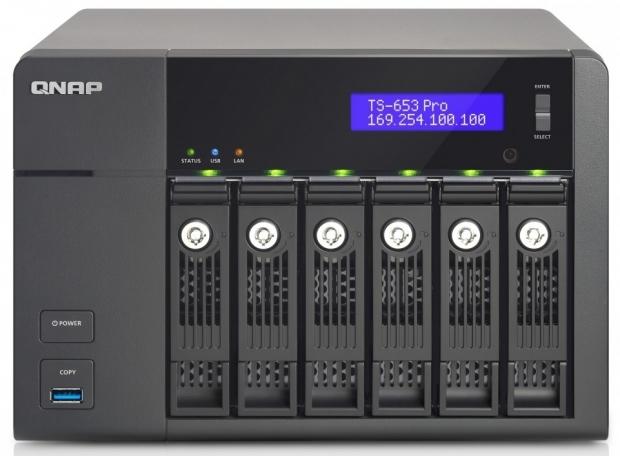
It's been over a year since I last tested a QNAP product. Even though the company released several SMB and enterprise models, in 2014, QNAP mainly focused on consumer and entry-level products. The new TS-x53 product series allows QNAP to once again focus on the SMB market, and take a different path than competitors this time.
For this series, QNAP chose Intel's Bay Trail SoC processor line, rather than Avoton or Evansport processors that are widely adapted by the NAS market. The higher spec Bay Trail quad-core Celeron allows QNAP to take advantage of advanced functions and features. These include the ability to configure a NAS with up to four gigabit Ethernet ports, HDMI 1.4 with hardware accelerated transcoding (that actually works), and even the ability to run a Windows or Linux installation through a virtual environment.
QNAP's QTS operating system has progressed since the last time I tested a QNAP SMB system. Now up to version 4.1.1, the OS works seamlessly with the latest generation hardware, and enhances the system with features like SSD cache, real-time remote replication, remote access to the system through the cloud, and a seemingly endless number of third-party applications.
Hardware Specifications and Pricing
Modern NAS servers have moved beyond data storage through a wire network. In order to get the most out of a NAS, you need to look at the extra I/O interfaces, and the mountains of software features.

The QNAP TS-653 Pro we're testing today uses an Intel Celeron quad-core processor running at 2GHz. The processor can burst to 2.41GHz, like most desktop processors can increase speed through Turbo. The TS-653 Pro is offered in two memory configurations, 2GB and 8GB. QNAP recommends the 8GB model for users taking advantage of virtualization functions. Purchasers of the 2GB model can also opt to add a DRAM to the system.
The system has six native SATA 6Gbps drive bays with locks on each drive sled. IO options come in the form of four gigabit Ethernet ports, and five USB ports, three 3.0 and two 2.0. The system also has an HDMI 1.4a port that can be used with XMBC, or for the QvPC virtualization.
We found the QNAP TS-653 Pro online for just $899 with a two-year warranty via the U.S. Newegg website. Both the 2GB model ($900.99) and the 8GB DRAM model ($1,255.29) are also available at the time of writing. This model carries a two-year warranty.
PRICING: You can find the QNAP TS-653 Pro for sale below. The prices listed are valid at the time of writing, but can change at any time. Click the link to see the very latest pricing for the best deal.
United States: The QNAP TS-653 Pro (2GB RAM) retails for $900.99 at Amazon, and the QNAP TS-653 Pro (8GB RAM) retails for $1,044.99 at Amazon.
Canada: The QNAP TS-653 Pro (2GB RAM) retails for CDN$1,179.47 at Amazon Canada, and the QNAP TS-653 Pro (8GB RAM) retails for CDN$1,443.09 at Amazon Canada.
Software Features
NAS products are equal parts hardware performance, and software features; one compliments the other in a balanced product. You need more hardware performance to run more software features at the same time.

QNAP's QTS 4.1 software offers more features than we can talk about in a single session here. You would need a vast number of pages just to scratch the surface.
Recent feature additions include hardware accelerated transcoding that works on both and LAN and WAN (cloud). Virtualization is another new feature that is worthy of mentioning. You can use the system like a Hyper-V or ESXi server to host operating systems, or even use the TS-653 Pro as a standalone computer with a mouse, keyboard, and monitor.
Packaging and Accessories
Packaging

The QNAP TS-653 Pro ships in a full retail package that is loaded with product information, feature lists, and use cases.

Here we see seven such uses, and this is only on one side of the package.

The QNAP TS-653 Pro is well protected inside of the package with dense, closed cell foam on each corner. The foam is thicker on the corners since these are the areas more susceptible to damage. The extra foam padding all but eliminates any chance of possible damage during shipping.
Accessories

Inside of the package, we found a paper quick install manual, two Ethernet cables, a power cable, keys for the locking drive bays, and two sets of screws for securing drives in the drive bays.
QNAP TS-653 Pro
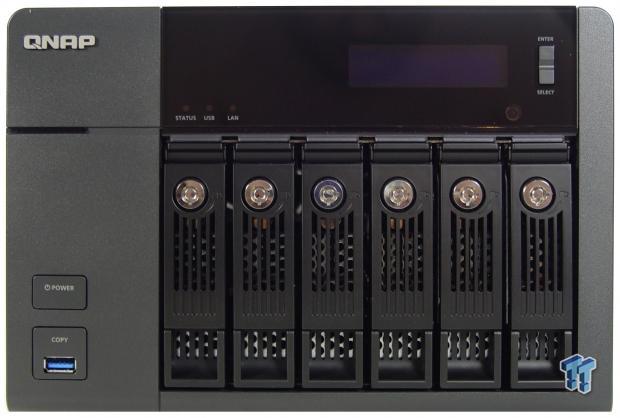
Here we get our first look at the QNAP TS-653 Pro. QNAP's design for this range of products hasn't changed in many years, but the design is timeless; it looks as good now as it did when first released.

On the bottom left side, we found the power button, as well as a one-touch copy button for USB devices. With this feature, you plug in a USB storage device, hit the copy button, and the system will automatically copy all of the data, and put it in a special folder in the NAS file system.

Three status LEDs keep users up-to-date on the systems status, USB transfers (so you don't prematurely pull your USB drive out during a copy session), and LAN activity.

A large status screen allows system administrators to peer into system details, and even change a limited number of settings with the two buttons just to the right of the screen. The TS-653 Pro also has an IR sensor, so users can use remote controls with the NAS.

The TS-653 Pro has six locking drive bays. The drive sleds are vented, so air can pass through the cages and cool the drives.
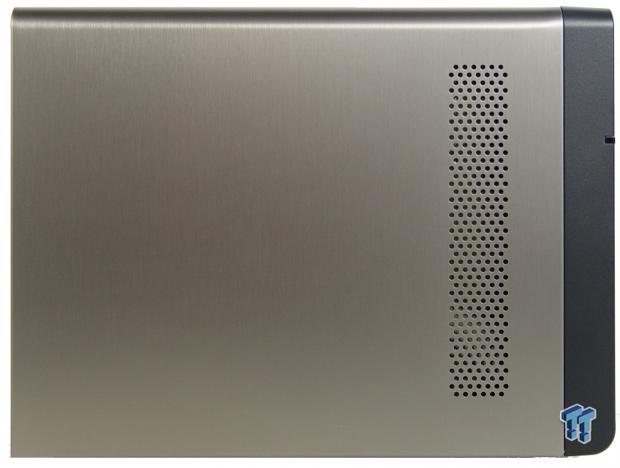
One side of the system has additional ventilation to keep the inner components cool.

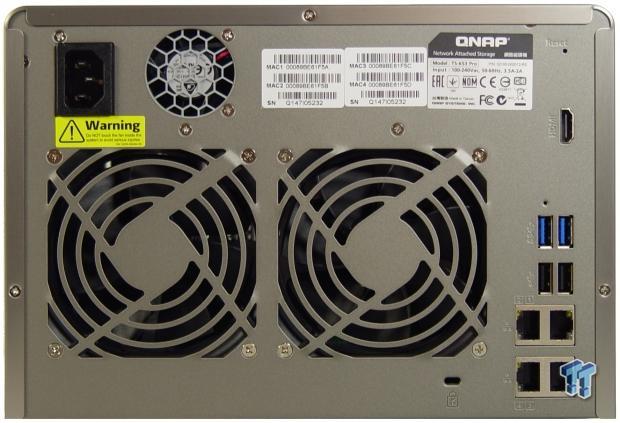
Nearly all of the IO ports are on the back of the system. The TS-653 Pro uses two large fans to keep the internal components cool. The internal power supply has a dedicated fan as well. At idle, and in use, the system is very quiet. I would even go as far as to say the system is silent from two feet away. I wouldn't hesitate to use this system on my work desk.

The power supply is internal, so you don't need to worry about a wall wart or power brick with this system.

A reset button is recessed in the NAS, and allows users to quickly reset the IP address of the system without deleting all of the data stored on the array. This unit also has a HDMI port for audio and video output to other devices like TVs.

Two additional USB 3.0 ports, and two USB 2.0 ports are on the back of the system. You may notice this system doesn't have an eSATA port. Four gigabit Ethernet ports allow users to attach the system to four different networks, or to team the adapters for increased throughput.
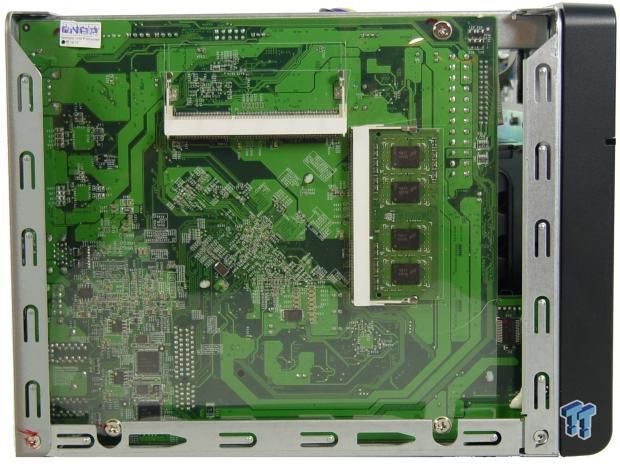
Our system shipped with 2GB of DRAM, but QNAP also sells a TS-653 Pro model with 8GB of DRAM. Users can easily upgrade the system with more RAM by removing the outer shell, and installing another SO-DIMM module.
Test System Setup
Test System

Our NAS test 'system' has migrated to three 42u racks, which is similar to what you'd find in a datacenter. There are ten servers that attack the target NAS with 120 Hyper-V installations of Windows 8.1 64-bit, each with a dedicated gigabit Ethernet port. The systems feed to three Extreme Networks X450e-48p switches, and then to a Supermicro SSE-X3348TR top-of-rack switch. The test device connects to the Supermicro switch via 1GbE, 10GbE, or 40GbE. The iSCSI and NASPT tests use a single machine connected to the Supermicro switch.
This level of testing wouldn't be possible without the help and support from several companies, many of which have little to do with NAS products. We would like to thank AVADirect, Antec, Corsair, GIGABYTE, Icy Dock, Kingston, LSI, Noctua, Rosewill, Seagate, Thermaltake, and Western Digital for their much-appreciated support.
Intel NASPT
The Intel NAS Performance Toolkit (NASPT) is a file system exerciser and analysis tool designed to enable direct measurement of home network attached storage (NAS) performance. Designed to emulate the behavior of an actual application, NASPT uses a set of real-world workload traces gathered from typical digital home applications. Traces of high definition video playback and recording, office productivity applications, video rendering/content creation, and more, provide a broad range of different application behaviors.
TweakTown Custom 120-Client Office Test
The TweakTown Custom 120-client Office Test uses 120 Windows 7 Hyper-V installations, and custom software to stress each NAS with traces from Microsoft Office tasks. Both throughput (in Mbits per second), and latency (in milliseconds) are measured.
Seagate NAS HDD
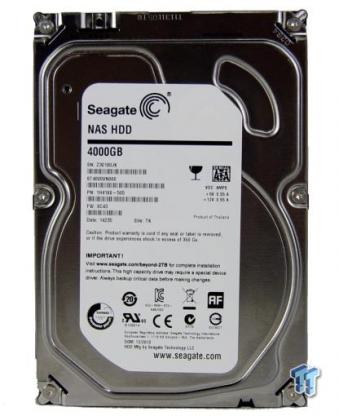
TweakTown uses Seagate NAS hard drives for all of our NAS tests. You can read our full review of the Seagate NAS HDD here.
Supermicro SSE-X3348TR 10GbE / 40GbE Switch

With a switching fabric of 1284 Gbps through forty-eight 10GBaseT, and four 40GbE ports, the SSE-X3348TR is our switch of choice for testing SMB and enterprise network attached storage products. You can read our full review of the Supermicro X3348TR top-of-rack switch here.
Initial Performance






If you read our consumer SSD reviews, then you've already seen the new initial performance tests. These tests were originally designed for NAS / SAN use, as you see here. In each chart, we have CIFS / SMB, as well as iSCSI performance. Both sets are run at queue depths one and four.
Benchmarks - RAID 5 Single Client Performance
Benchmarks - RAID 5
RAID 5: Block-level striping with parity data distributed across all member disks.
HD Video Playback

HD Video Play - 720p HD stream from Windows Media Player 256kB reads
2HD Video Play - 2x playback
4HD Video Play - 4x playback
HD Video Record

HD Video Record - 720p HD stream, 256kB writes
HD Video Play & Record - one playback, one record simultaneously
2x HD Video Play & 2x Record - two playback, two record simultaneously
Content Creation

Photo Album - All reads - Wide distribution of sizes
Office Productivity - Reads and writes; 1kB & 4kB reads; mostly 1kB writes
Content Creation - 95% writes; 1k, 4k, & little reads; Writes up to 64kB
File / Directory Transfer

Directory Copy From NAS - 64kB reads
Directory Copy To NAS - Predominantly 64kB writes; wide scattering under 16kB
File Copy From NAS - 4GB file copy; 64kB reads
File Copy To NAS - 64kB writes
Single Client Performance Summary
You will almost immediately notice two QNAP TS-653 Pro results in our charts today. The first is a five-drive, RAID 5 array with a SuperSSpeed S301 120GB SLC SSD installed as a cache drive. The second configuration is with six drives, also in RAID 5.
The first thing we notice in the single client tests is the SSD cache performance in relation to the non-cached performance. For a majority of these tests, the cache actually slows the TS-653 Pro down, but only by a very small and unnoticeable margin. The QNAP 4.1 software allows users to set different perimeters for the cache SSD; we ignored sequential data, and just accelerated random data, which is the default option. In the single client tests where random data is present, the cache option increased performance as expected.
Benchmarks - iSCSI Database and Workstation Workloads
Benchmarks - Database Workload
IOPS

Latency

Outstanding IO

We were surprised the SSD cache array didn't significantly outperform the non-cached array in the TS-653 Pro for this test. Both configurations show a flat line of performance, with just a slight increase as the queue depth was dialed up.
Benchmarks - File Server Workload
IOPS

Latency

Outstanding IO

Oddly enough, the file server test saw a nice increase in transfer performance with the SSD cache option enabled.
Benchmarks - iSCSI Server Workloads
IOPS

Latency

Outstanding IO

The email server test saw a very large performance increase with the cache option enabled. By adding a SSD to the system, the TS-653 Pro moves from providing average email server performance to providing excellent email server performance.
Benchmarks - Web Server Workload
IOPS

Latency

Outstanding IO

The same is true for the web server test. The TS-653 Pro goes from being one of the lowest performing units on our chart to being a rocket ship that significantly outperforms everything else we see today.
Benchmarks - Workstation Workload
IOPS

Latency

Outstanding IO

Our last iSCSI workload test again shows strong performance with a SSD installed in the system as a cache for the array.
Benchmarks - Multi-Client Test
The Intel NAS Performance Tool (NASPT) is an excellent way to determine NAS performance in a single user environment. Any review that only uses NASPT assumes that only a single computer will access the target NAS at one time. We took issue with this method of testing, and spent over a year designing, building, programming, and finally validating the TweakTown Multi-Client Test.
The test uses Microsoft Office data recorded to traces and played back to the NAS from up to 120 client Windows 7 installations (clients). We record total throughput of all clients, and average response time per client.
Over time, we'll populate the two multi-client charts with several NAS products from a span of categories. The products range from a dual Xeon server with 2x 10GbE to a two-bay NAS with a single gigabit Ethernet connection. The products will fall into their performance categories based on performance, and not marketing material, or opinion.
Throughput

The QNAP TS-653 Pro doesn't perform all that well in our multi-client test, even with the cache SSD option. This system wasn't designed to run at the highest workloads this test subjects the system to, but we still expected this system to perform a bit better than it did.
Latency

Here we see the latency chart from the same test. This shows us a bit more detail, and at what workload the latency starts to climb. Even at seven milliseconds of latency with 120 clients, the TS-653 Pro doesn't do too badly, but when you compare the performance to other products, this unit is technically a bit slower.
Final Thoughts

The TS-653 Pro continues QNAP's tradition of bringing innovative features to the market first. The new Virtualization Station feature is a good example of a truly useful feature that QNAP brought to the market, and in time, I'm sure it will be copied across the market.
QNAP's decision to utilize Intel's higher spec Bay Trail quad-core processor should greatly influence users looking to take advantage of the higher processing speed, and features. We get a lot of questions about transcoding capabilities of NAS products from readers, and this is a feature many use in the home, and on the road.
When it comes to our testing today, there were some high points, and some low points when comparing the transfer performance to other products on the market. Our testing focuses on the small details, but I highly doubt many would notice a few megabytes per second gained or lost here and there. In some workloads, the SSD cache option does increase the performance of the system enough to make a difference.
At $899 for the 2GB DRAM model, the QNAP TS-653 Pro is well positioned in comparison to competing products on the market. This series has a lot of really nice features that are not found on other products, which makes it easy to recommend this model after looking at prices of other six and seven-bay NAS products on the market today.
PRICING: You can find the QNAP TS-653 Pro for sale below. The prices listed are valid at the time of writing, but can change at any time. Click the link to see the very latest pricing for the best deal.
United States: The QNAP TS-653 Pro (2GB RAM) retails for $900.99 at Amazon, and the QNAP TS-653 Pro (8GB RAM) retails for $1,044.99 at Amazon.
Canada: The QNAP TS-653 Pro (2GB RAM) retails for CDN$1,179.47 at Amazon Canada, and the QNAP TS-653 Pro (8GB RAM) retails for CDN$1,443.09 at Amazon Canada.
